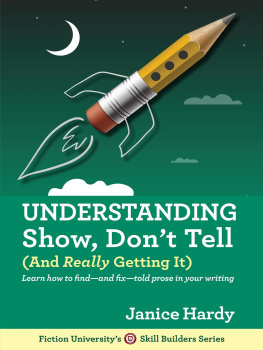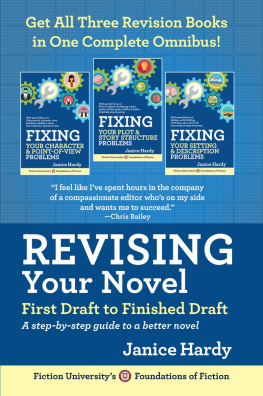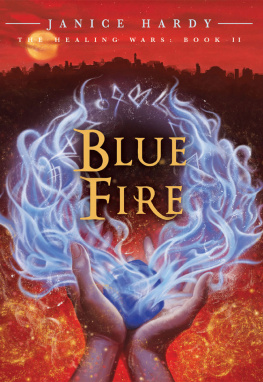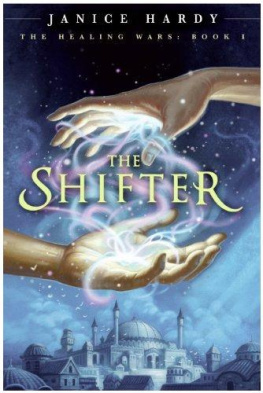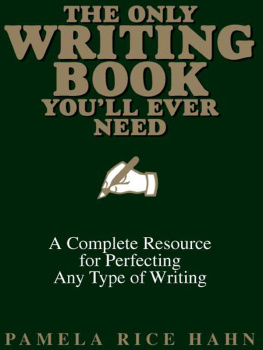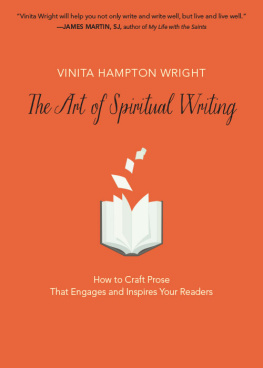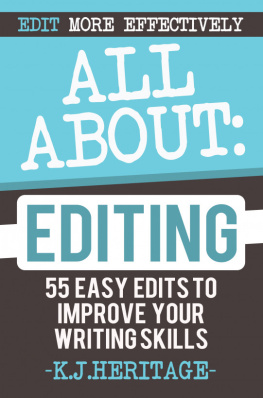Fiction University's
Skill Builders Series
Understanding Show, Don't Tell
(And Really Getting It)
By
Janice Hardy
Understanding Show Dont Tell (And Really Getting It)
Copyright 2016
Janice Hardy
This book also available in print.
All rights reserved. No part of this publication may be reproduced, stored in a retrieval system, or transmitted in any form or by any means electronic, mechanical, photocopying, recording, or otherwise without the prior written permission of the publisher and copyright owner.
Published by Fiction University Press.
ISBN 978-0-9915364-4-3
Books by Janice Hardy
Foundations of Fiction Series:
Planning Your Novel: Ideas and Structure
Planning Your Novel Workbook
Revising Your Novel: First Draft to Finished Draft
Skill Builder Series:
Understanding Show, Dont Tell (And Really Getting It)
Understanding Conflict (And What It Really Means)
Novels by Janice Hardy
The Healing Wars Trilogy:
The Shifter
Blue Fire
Darkfall
Welcome to Understanding Show Don't Tell (And Really Getting It)
About the Author
More from Janice Hardy
Show, dont tell is one of the most frustrating pieces of writing advice out there. Its ambiguous, it changes depending on who you ask, and most of the time, no one tells you how to put that advice into practice.
This helpful-yet-unhelpful advice drove me crazy as a new writer, but it did send me down the path to where I am todaythis book (and my writing site, Fiction University) wouldnt exist if I hadnt been so determined to figure out how this writing stuff worked. I cant tell you how many published novels I analyzed, and how many manuscripts I studied, or how many sentences I tore apart to figure out how they worked.
It took a lot of effort, but it was worth it. I discovered that told prose often included the same words, or the same types of words. I created lists of these red flag words so I could easily search for them during my revisions. As I edited sentences to eliminate those words, my writing improved. It wasnt long before I instinctively stayed away from those words in a first draft.
To save you all that effort, Ive collected what Ive learned so you can put my hard-won findings into practice. This is more than just advice on what to do and what not to doits a down and dirty examination and analysis of how show, dont tell works, so youll be able to adapt the rules to whatever style or genre youre writing.
Once you understand it, youll never have to worry about it again.
And wouldnt that be nice?
U NDERSTANDING SHOW Dont Tell is an in-depth study and analysis of what show, dont tell is, what it means, and how to use it in your writing. It will teach you how to identify told prose in your work, and where told prose is frequently found. It will even explore aspects of writing that arent technically telling, but are connected to told prose and can make prose feel told, such as infodumps, description, and backstory.
By the end of this book, youll have a solid understanding of show, dont tell and the ability to use it without fear or frustration.
S HOW, DONT TELL is critical to crafting a strong story, but what exactly does it mean? And more importantly, how do you make sure youre using it correctly in your writing?
Typical answer:
- Writing with strong nouns and verbs to dramatize a scene
- Using the senses to enable the reader to experience what the point-of-view character experiences
- Dramatizing scenes versus explaining them
Is any of that actually helpful?
Probably not, because even when you know what people mean when they say, show and not tell, its not always clear what to do about it. If you cant identify where the told prose is in your novel, you cant fix it, and you end up making the same mistakes over and over until you want to pull your hair out. Even worse, shown prose isnt always better than told prose, so simply swapping out those weak, told verbs for strong, shown ones might not make the writing any better.
Lets start with a basic example of a common way to tell:
- I reached over to pick up the cup.
Youre likely thinking, Whats wrong with that? It looks fine to me. For the most part, yes it is fine and writers write sentences like this every day. As told prose goes, its minor, but it makes an excellent example of why show, dont tell trips up so many writers.
Break this sentence down and really analyze it. The first part, I reached over, is a physical and demonstrable action. You can physically reach over. To pick up is an explanation of why that person reached over. There is no actual picking up of the cup, just the stated intention to do so, and you cant show intention. However, you can show the observable results of intention. Change one tiny word and suddenly this same sentence shows instead of tells.
- I reached over and picked up the cup.
Both are physical and demonstrable actions. Both can be observed. You can reach over, and you can pick up a cup.
Whats considered told prose gets even stickier when you look deeper. Since this is in first-person point of view, the character knows exactly why shes reaching over, so her saying to pick up the cup is accurate. She knows why shes reaching. Her explaining her motivation for reaching doesnt feel out of place, so even though it tells, its not something that will jar a reader out of the story or feel awkwardwhich is why nobody gets all that upset about this type of tell.
Lets take that same sentence and put it in a tight third-person point of view. Say Sally is the point-of-view character and shes watching Jane:
- Jane reached over to pick up the cup.
Now the point-of-view character is assigning motive to the reaching before the cup is even picked up. In this case, to pick up the cup is something Sally would not know until Jane does it. Shes explaining why Jane is reaching and theres no guarantee she knows why. It reads more as the author explaining, and explaining is telling. Telling describes the situation, not the action.
But what if this was a third-person-omniscient point of view?
Then its acceptable for motive to be assigned because an all-knowing narrator would indeed know why everyone was acting.
And lets not forget stories where the characters are all relaying the information after the factas in, the events in the story have already happened and the book is retrospective. Then the point-of-view character assigning motive to events she already knows the outcomes of is valid. Telling in such cases is less jarring because it feels natural to that type of storytelling process.
Next page
